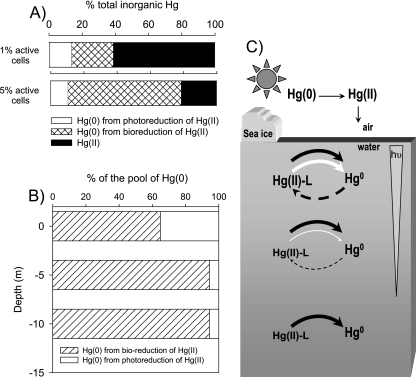FIG. 6.
Results of modeling of the relative importance of photochemical reactions versus biologically mediated reduction in mercury redox cycling in seawater in Arctic near-coastal environments. (A) Relative distribution of inorganic mercury species and proportion of Hg(0) formed by photochemical and microbial processes at the sea surface. In this example, photoreduction and photooxidation rates were considered to be 0.5 and 0.6 h−1, respectively, and the proportion of active bacterial cells was assumed to be 1 or 5%. (B) Relative importance of photochemical versus microbial contributions to the pool of Hg(0) at the surface and at depths of 5 and 10 m. (C) A proposed model for redox cycling of mercury in the water column of Arctic near-coastal marine environments. Arrow width correlates with the relative quantitative contribution of the depicted process to the total activity at each depth. Black, white, and dashed-line arrows represent microbially mediated reduction, photoreduction triggered mostly by UVB, and photooxidation triggered mostly by UVA, respectively. The gray inverted triangle depicts the gradient of light penetration with depth.

